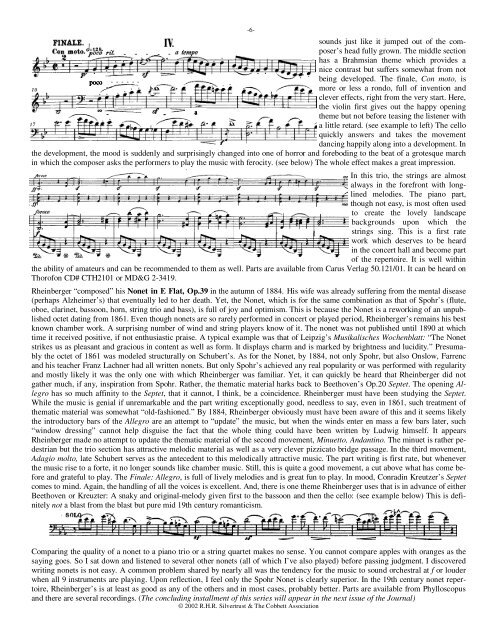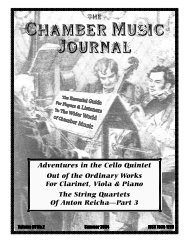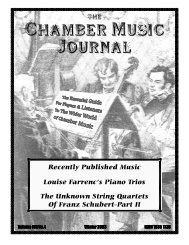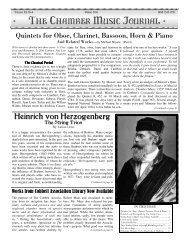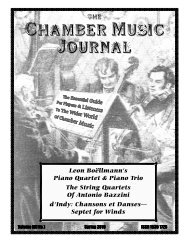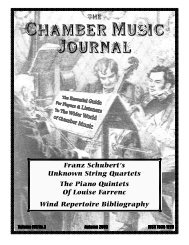Volume 13 No.1
Volume 13 No.1
Volume 13 No.1
Create successful ePaper yourself
Turn your PDF publications into a flip-book with our unique Google optimized e-Paper software.
-6-<br />
poco - - - - - -<br />
sounds just like it jumped out of the composer’s<br />
head fully grown. The middle section<br />
has a Brahmsian theme which provides a<br />
nice contrast but suffers somewhat from not<br />
being developed. The finale, Con moto, is<br />
more or less a rondo, full of invention and<br />
clever effects, right from the very start. Here,<br />
a<br />
the violin first gives out the happy opening<br />
theme but not before teasing the listener with<br />
a little retard. (see example to left) The cello<br />
quickly answers and takes the movement<br />
dancing happily along into a development. In<br />
the development, the mood is suddenly and surprisingly changed into one of horror and foreboding to the beat of a grotesque march<br />
in which the composer asks the performers to play the music with ferocity. (see below) The whole effect makes a great impression.<br />
In this trio, the strings are almost<br />
always in the forefront with longlined<br />
melodies. The piano part,<br />
though not easy, is most often used<br />
to create the lovely landscape<br />
backgrounds upon which the<br />
strings sing. This is a first rate<br />
work which deserves to be heard<br />
in the concert hall and become part<br />
of the repertoire. It is well within<br />
the ability of amateurs and can be recommended to them as well. Parts are available from Carus Verlag 50.121/01. It can be heard on<br />
Thorofon CD# CTH2101 or MD&G 2-3419.<br />
Rheinberger “composed” his Nonet in E Flat, Op.39 in the autumn of 1884. His wife was already suffering from the mental disease<br />
(perhaps Alzheimer’s) that eventually led to her death. Yet, the Nonet, which is for the same combination as that of Spohr’s (flute,<br />
oboe, clarinet, bassoon, horn, string trio and bass), is full of joy and optimism. This is because the Nonet is a reworking of an unpublished<br />
octet dating from 1861. Even though nonets are so rarely performed in concert or played period, Rheinberger’s remains his best<br />
known chamber work. A surprising number of wind and string players know of it. The nonet was not published until 1890 at which<br />
time it received positive, if not enthusiastic praise. A typical example was that of Leipzig’s Musikalisches Wochenblatt: “The Nonet<br />
strikes us as pleasant and gracious in content as well as form. It displays charm and is marked by brightness and lucidity.” Presumably<br />
the octet of 1861 was modeled structurally on Schubert’s. As for the Nonet, by 1884, not only Spohr, but also Onslow, Farrenc<br />
and his teacher Franz Lachner had all written nonets. But only Spohr’s achieved any real popularity or was performed with regularity<br />
and mostly likely it was the only one with which Rheinberger was familiar. Yet, it can quickly be heard that Rheinberger did not<br />
gather much, if any, inspiration from Spohr. Rather, the thematic material harks back to Beethoven’s Op.20 Septet. The opening Allegro<br />
has so much affinity to the Septet, that it cannot, I think, be a coincidence. Rheinberger must have been studying the Septet.<br />
While the music is genial if unremarkable and the part writing exceptionally good, needless to say, even in 1861, such treatment of<br />
thematic material was somewhat “old-fashioned.” By 1884, Rheinberger obviously must have been aware of this and it seems likely<br />
the introductory bars of the Allegro are an attempt to “update” the music, but when the winds enter en mass a few bars later, such<br />
“window dressing” cannot help disguise the fact that the whole thing could have been written by Ludwig himself. It appears<br />
Rheinberger made no attempt to update the thematic material of the second movement, Minuetto, Andantino. The minuet is rather pedestrian<br />
but the trio section has attractive melodic material as well as a very clever pizzicato bridge passage. In the third movement,<br />
Adagio molto, late Schubert serves as the antecedent to this melodically attractive music. The part writing is first rate, but whenever<br />
the music rise to a forte, it no longer sounds like chamber music. Still, this is quite a good movement, a cut above what has come before<br />
and grateful to play. The Finale: Allegro, is full of lively melodies and is great fun to play. In mood, Conradin Kreutzer’s Septet<br />
comes to mind. Again, the handling of all the voices is excellent. And, there is one theme Rheinberger uses that is in advance of either<br />
Beethoven or Kreuzter: A snaky and original-melody given first to the bassoon and then the cello: (see example below) This is definitely<br />
not a blast from the blast but pure mid 19th century romanticism.<br />
Comparing the quality of a nonet to a piano trio or a string quartet makes no sense. You cannot compare apples with oranges as the<br />
saying goes. So I sat down and listened to several other nonets (all of which I’ve also played) before passing judgment. I discovered<br />
writing nonets is not easy. A common problem shared by nearly all was the tendency for the music to sound orchestral at f or louder<br />
when all 9 instruments are playing. Upon reflection, I feel only the Spohr Nonet is clearly superior. In the 19th century nonet repertoire,<br />
Rheinberger’s is at least as good as any of the others and in most cases, probably better. Parts are available from Phylloscopus<br />
and there are several recordings. (The concluding installment of this series will appear in the next issue of the Journal)<br />
© 2002 R.H.R. Silvertrust & The Cobbett Association


